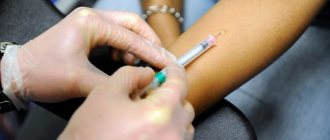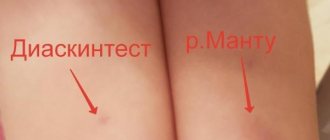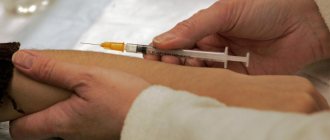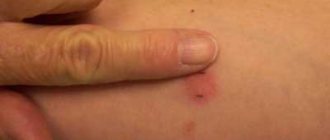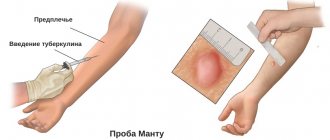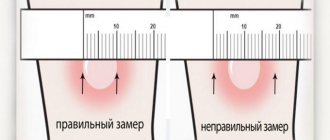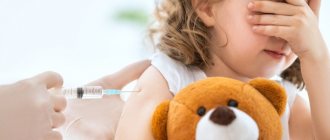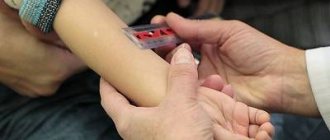Useful articles / August 12, 2019
- Don’t get it wet, don’t scratch, don’t eat chocolate—everyone knows these prohibitions from childhood. The papule at the site of the Mantoux test was carefully protected from any external influence and measured every day with a ruler. The worst thing was if the “button” increased, because in this case the child could be sent to a tuberculosis clinic for examination. Why is it necessary to diagnose tuberculosis if the era of epidemics is long gone?
The anti-vaccination movement is not losing its position. If earlier parents protected their children from diseases with the help of vaccinations, now everything is exactly the opposite - children are protected from vaccination by hook or by crook. Sometimes there is a substitution of concepts and any outside intervention is perceived negatively by moms and dads. This often happens in relation to the diagnostic test for tuberculosis - Mantoux and Diaskintest. Despite the fact that this has nothing to do with vaccination, many mothers perceive the Mantoux test and Diaskintest as a vaccination and try to refuse it. What does this mean? We talked about all this with Nina Dmitrievna Chulikova, a phthisiatrician with 30 years of experience at the tuberculosis dispensary in Sochi.
Mantoux test and Diaskintest: how are they different and what will they show?
For the first time, newborns encounter the vaccine against tuberculosis - BCG (from the English BCG, bacillus Calmette-Guérin) in the maternity hospital. Repeated revaccination is necessary before the age of 7 years - the Mantoux test is used for this. What is the Mantoux test and why is it needed?
The first thing to remember is that this is not a vaccine and it does not put any strain on the immune system. The Mantoux reaction is a stage of protection against tuberculosis, a way to avoid the development of the disease and possible complications. The child is injected subcutaneously with tuberculin (a highly purified, destroyed tuberculosis pathogen), and the result is assessed at the injection site a few days later. If the child has been in contact with a patient with tuberculosis, a local reaction will follow and the papule will increase in size. The Mantoux test is necessary to send a child for repeated revaccination at 7 years of age.
“In order to refer a child for repeated revaccination, we must obtain a negative Mantoux test for 3 years in a row,” explains Nina Chulikova. — If in the first year after BCG we get a 10 mm papule, this indicates that the body has given a good response to the administration of the BCG vaccine. By age 3, this reaction subsides. From 7 to 18 years of age, a child is given a Diaskintest; the technique of its administration is the same as Mantoux. But these are two different types of diagnostic tests.
The Mantoux test shows the presence of Mycobacterium tuberculosis in the body, and the Diaskintest shows their activity. Tuberculin, which is used for the Mantoux test, contains about 250 different proteins that react to Koch's bacillus. Diaskintest is more purified, accurate and less allergenic. It contains only two proteins found in the strains that cause tuberculosis. There is also an alternative to skin testing - T-SPOT. The presence of Mycobacterium tuberculosis in the body is detected using a blood test, without interfering with the human body. Blood is examined in laboratory conditions. Read more about T-SPOT analysis in our material.
Mycobacterium tuberculosis in the body. Is it dangerous?
Is the presence of mycobacteria in the body dangerous? Mycobacterium tuberculosis can be detected in many people’s bodies (according to statistics in Russia, they are found in 95% of the population!), but this does not mean that the person has tuberculosis or will become ill with it. With good immunity, these bacteria are destroyed by the body or are in a dormant state and do not pose any threat to the body.
The Mantoux test shows the state of anti-tuberculosis immunity. If the result is positive, then a diaskintest is performed to exclude allergic reactions. If a child has a positive result for Diaskintest, this means that the immune system cannot cope with the infection and a latent form of tuberculosis is present. An examination by a TB specialist, additional examination and treatment will be required so that tuberculosis does not become active. An important point: latent tuberculosis is not a disease, but the presence of mycobacteria in the human body at the stage of active reproduction. There are no foci of the disease, but if therapy is not carried out, then in a couple of years latent tuberculosis will enter the active stage. In other words, the disease must be “caught” at the latent stage, when infection occurs, but no altered areas are found in the lungs.
“I’ll give you an example: a child has had a viral infection several times in a row, his immunity has dropped, and at that moment he comes into contact with a patient with tuberculosis,” explains Nina Chulikova . — The immune system is weakened and Mycobacterium tuberculosis begins to manifest itself. After a positive result of the diaskintest, a CT scan of the chest, an extensive blood and urine test, and an ultrasound of the abdominal cavity are prescribed, since tuberculosis of the abdominal lymph nodes can occur in children. Why computed tomography? Because not everything can be seen in detail on a survey x-ray. If the test is positive, layer-by-layer sections from different surfaces are required.
Can the Mantoux test give a false result when in contact with water? For many years there was a stereotype that this could be affected by drinking water or eating certain foods.
“If the child is not infected, then the Mantoux test will not increase after water gets on it,” notes Nina Chulikova. — You can wet it, it won’t affect the result. As for scratching the papule, itching can appear when the placement technique has been violated, as well as when it comes into contact with synthetic fabrics or clothing that fits tightly to the skin. But, of course, it’s better not to rub the papule too much.
What results should a child have at 1 year of age?
The Mantoux reaction in children aged 1 year is assessed, as in older children and schoolchildren, three days later. But there are some differences, since, as mentioned above, the baby’s immunity is still in the process of formation. The Mantoux reaction in a 1-year-old child, like in older children, can be positive, doubtful or negative:
Negative Mantoux test at 1 year
Normally, the size of the first papule is no more than 1 mm, there is no redness or induration, only a small mark from the injection.
Questionable Mantoux reaction at 1 year
The seal dimensions exceed 1 mm, but not more than 4 mm. In this case, the boundaries of the papule are clearly defined, it rises noticeably above the surface of the skin, and a red halo often forms around it. Such a reaction may occur if the tuberculin test was performed in violation of the technique. Or the parents did not follow the doctor’s recommendations at home. But sometimes this is a sign of a true tuberculosis infection, so it will be necessary to conduct additional examinations, show the baby to a phthisiatrician, and also check his environment to detect the spreader of the infection.
Characteristics of a positive Mantoux test at 1 year
If the papule is 4 mm larger than normal, then we are talking about a positive reaction. The bump and redness are pronounced. First of all, a repeat tuberculin test will be performed, and only after receiving its results the doctor will tell you what to do next.
Hyperergic reaction
It manifests itself in the formation of a large blister, abscess, or ulcer at the site of tuberculin injection; the diameter of the papule can reach 15-17 mm. The reasons for a positive reaction are most often the presence of a large number of Mycobacterium tuberculosis in the child’s body. In some cases, this may be due to improper care after the test.
But if there is no trace of Mantoux at 1 year, there is no need to rush to rejoice either. This may indicate that the child, after vaccination with BCG in the maternity hospital, simply did not develop immunity to a dangerous disease.
Important! In infants, the scar after BCG vaccination will also be assessed along with the results of the tuberculin test. If the scar is clearly visible on the child’s skin, most likely the reaction to Mantoux will be positive.
In this case, you should only worry if the diameter of the papule exceeds 16 mm. You should also urgently consult a doctor if there is no scar after BCG (this means that the vaccine against tuberculosis did not work), and the Mantoux test gave a positive result.
Refusals from the Mantoux test: what is the reason and what are the dangers?
Epidemics of diseases are a thing of the past and it seems that they will never return. For this reason, many parents refuse vaccinations, not seeing their benefits. This reduces the number of immune layers in the population, which may threaten new epidemics in the future. The trend of tuberculosis disease in the world is decreasing, but this does not mean that we need to abandon the BCG vaccine and subsequent diagnosis of immunity. According to WHO, about 11 million people in the world fall ill with tuberculosis every year, and 1 million of them are children.
“For unknown reasons, parents refuse the Mantoux test and Diaskintest,” says Nina Chulikova. “Moreover, they also refuse to take x-rays.” It can be difficult to explain to modern parents that diagnostic tests are safe, are administered intradermally and only the infected organism reacts to them. If tuberculosis is detected in a timely manner, it responds well to treatment and there will be no consequences.
What happens if an infected child goes to school or kindergarten? It is worth remembering that tuberculosis is a bacteria extremely adapted to the environment. Just imagine that it remains active even at -40C! The mycobacterium lives in dried sputum on clothes for up to 3–4 months, on books for up to 6 months, and in dairy products for up to a year. You can become infected with Koch's bacillus through airborne droplets. If a child with tuberculosis visited a child care facility, then it is necessary to examine everyone who was in contact with the sick person and offer preventive treatment. Both the entire children's team and the employees of the school or kindergarten would automatically be at risk.
What could be the best prevention of tuberculosis? Phthisiatricians never tire of repeating that the main prevention is a healthy lifestyle, hygiene and careful attention to your health and the health of your children. And, of course, listen to the recommendations of doctors - do fluorography for yourself every year and do not refuse Mantoux tests and Diaskintest for your children.
Why is Mantoux needed at 1 year old?
Norma Mantoux at 1 year
Not all parents understand why a baby of this age is given an injection and made to suffer. Many also seriously believe that tuberculin tests are the same as vaccination, which means that the child can become infected with a dangerous disease.
In fact, tuberculin contains only killed bacteria of the human and bovine tuberculosis strain, so the risk of infection is reduced to almost zero. But it is pointless to perform tuberculin tests before the age of one year. As many years of medical practice have shown, at this age the results of the Mantoux test in children at this age often turn out to be false. This is due to the intensive formation of immunity, including to tuberculosis, after the BCG vaccination given in the first days after the birth of the baby. This is why it is necessary to get the first Mantoux vaccination at 1 year of age.
Sometimes tests are postponed if, for some reason, BCG vaccination in the maternity hospital was postponed and performed 1-2 months later. In this case, Mantu is given at about a year and a half - the timing depends on how much the anti-tuberculosis vaccination was delayed and for what reasons. This method is considered safe and does not threaten children's lives. Mantoux is needed more often at 1 year of age if the baby has had contact with people infected with tuberculosis or there is a suspicion that there has been a health-threatening contact.
What can distort the Mantoux reaction and enlarge the papule?
The Mantoux reaction will be incorrectly assessed, and the size of the papule will be larger than the true size if there is:
- previous infection in the current month;
- vaccination or administration of immunoglobulins, serums, immune stimulants;
- diseases of internal organs in the acute stage;
- worsening of allergic and skin diseases;
- mid-menstrual cycle in girls;
- helminthic infestation;
- insect bite;
- frequent contacts with tuberculosis patients;
- tuberculin diagnosis more than once a year;
- thyrotoxicosis (excess of thyroid hormones);
- scratching, lubricating or covering the papules with an adhesive plaster.
Errors in performing the Mantoux test (for example, violation of the injection technique) cannot be completely excluded. Therefore, in all cases of a reaction unusual for a child, a diagnosis is not immediately made; to confirm it, blood tests, Diaskintest, and chest x-ray are performed.
If you are aware of a tendency to allergies, the doctor recommends taking medications with an antiallergic effect (for example, Suprastin, Claritin) 3 days before and 3 days after the test.
It is also important to exclude from the diet during this period all foods that cause food allergic reactions: honey, chocolate, eggs, fish, nuts, strawberries, and reduce the amount of sweets and flour in the diet.

